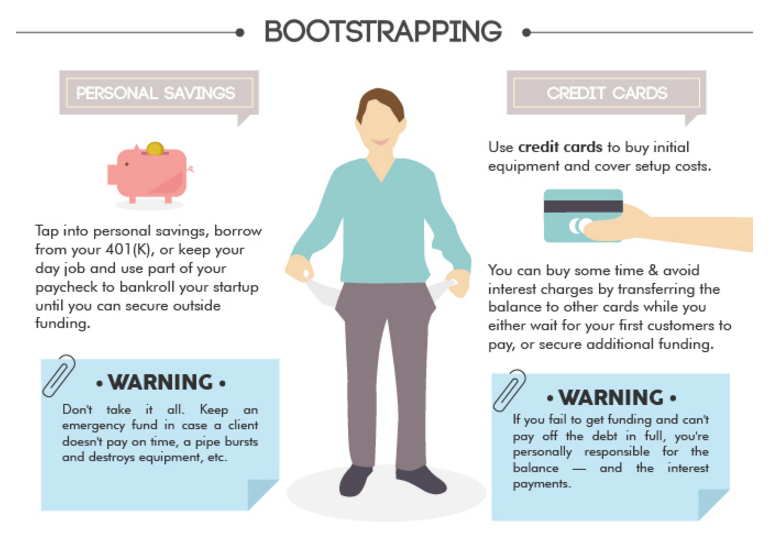New startup companies appear all the time, and many of them have the same problems searching for funding. According to statistics, most startups experience problems with raising funds. For an early-stage startup company, the success of funding to a large extent depends on a chosen funding model. As for the investors, they are not willing to take risks, knowing that only a few of a hundred startups actually succeed. Of course, it’s important to spot a promising startup, but the success also depends on investors. Some of them just choose inefficient ways of investment.
Popular Funding Models for Tech Startups
Bootstrapping
Perhaps, the most popular model chosen by many startups is bootstrapping. For many companies, it’s the only possible way to get by, however, it can be turned into an effective funding model. For example, MailChimp was created as a side gig but quickly became a billion-dollar project. The founders of the company have chosen to develop slowly, without attracting external investment. However, thanks to a short sales cycle and a viable product, these founders managed to get investment and to keep their full ownership at the same time. Investors also benefit from such companies, because when they ask for investment, they already can prove their value so that a potential investor can estimate profits.

Crowdfunding / Angel Investment
Simply put, crowdfunding is a way to share your company with others. Investors and startups can easily find each other on various crowdfunding platforms. For example, there are companies like Equitise, Our Crowd, or Venture Crowd which are mostly focused on crowdfunding. The best example of a successful angel investment is Facebook. In 2012, Peter Thiel sold his class A Facebook shares for as much as $400 million, which is a great return for a $500,000 investment. Angel investors usually are actively involved in the emerging business, being able to help founders eliminate typical difficulties inexperienced businessmen usually don’t foresee.
Venture Investment
This is an opportunity to take a large stake in a promising business for cheap. This approach allows a company to grow rapidly. This model is usually chosen by big projects with strong demand and reliable business models.
Venture capitalists usually don’t invest when companies are at the pre-IPO stage because strong financing from the start may play a bad joke on a company. Such companies may forget about the importance of perfecting their product and present a product that won’t withstand competition. A good example of a company that attracted investors but didn’t transform into a real business is Juicero.
Reasons to Invest in Early-Stage Tech Startups
* High risks bring the high return, of course, investing in new tech startups is risky. Nevertheless, if a company succeeds, it will bring you great profits. The tech industry grows exponentially, and investing in disruptive companies, you get an opportunity to repeat the success of people who invested in Facebook or Google.
* You can impact your investment You can ensure the success of some company by actively participating in its business. If you are familiar with marketing or accounting, or if you own other companies in a related industry, you can use these opportunities to make sure your investment will bring profits.
* Scale A few industries can scale as fast as tech companies at the early stage. The most common revenue model is SaaS, which stands for Software as a Service. The bigger the company, the more service it sells, and the bigger the profits. Early-stage startups can create something valuable just once and generate revenue from it for many years.
* Margins Costs associated with server space are constantly decreasing, and mobile devices offer almost unlimited opportunities. Tech companies have margins that may vary from 60% to 90% — a chance impossible to pass by.
How to Invest in High-Tech Startups Properly
1. Search for deal flow
There are two types of deal flow: outbound and inbound. The latter is the best but it’s also very rare. However, experienced investors increase inbound flow by publishing their content on all the possible platforms.
Investors also need to understand what role do they play in the funding cycle. If you are one of the reasons why some company exists, you need to show your influence and to use your contacts. Many startup companies realize that an angel investor who has ties to top super-angels and venture capitalists is much more valuable than one who just has a lot of money.
2. Understand the Market
It’s important to be able to estimate the target market of your startup and to check the sales cycles. For example, if some company is promising to have several deals with enterprises in a few months, you should ask yourself, do they actually know how to sell to that type of customers? We suggest sticking to the markets which are already familiar to you so that you can stay in touch with your company and control the business.
3. You Need to Organize Everything
You have to organize the working process so that you can control everything. You can use Google Apps, but there are also tools that were created especially for angel investment, helping startups organize their deal flow. For example, try such platforms as Seraf, Proseeder, Gust, or Streak.
4. Mentions and Marketing Stack
It’s better to choose a B+ product with a good marketing stack than an A+ product with a bad marketing stack. Tom Gianelli, a social media manager at College-Writers, notes: “If you are about to invest in some company, check its HubSpot and MailChimp accounts. Search for mentions on Twitter and use various social media monitoring tools to see app reviews.”
5. Understand People You Work With
This is the most important thing about investing in new startups. You should understand what is the founders’ motivation, and what are their values. We suggest getting help from companies like RoundPegg, which are specialized in the evaluation of teams and employees.
6. Put Analytics Over Gut Feel
For instance, there are plenty of process-driven startups that don’t have talkative CEOs who know how to sell their company. Thus, it’s important to properly analyze companies you’re dealing with. In addition, as the early-stage companies get more resources and more developed infrastructure, non-professional investors have to deal with competition. That’s why they should be able to analyze statistics and to estimate the potential of new companies at the very beginning.
7. You Need Data Points
The more data you have, the better. Start with checking a LinkedIn profile — it may have such information about a startup as the year it was created or the number of workers. Tools like Owler, Tracxn, CB Insights, or Mattermark will help with gathering and analyzing self-reported data.
Conclusion
Every decision for early investment should be properly measured, taking into account your long-term objectives. Angel investment, venture investment, and crowdfunding have their advantages and disadvantages, so you should choose a method of investment depending on your capabilities, goals, and instincts. Early-stage tech startups can be a very profitable type of investment. In addition, you can keep some percentage of ownership and actively participate in the business, making sure that the chosen company will succeed.
About the Author
Ester Brierley is a QA Engineer in software outsourcing company, a seasoned content creator for different digital blogs. Adores researching cutting-edge digital (and lifestyle) trends and sharing them in her writing pieces. Follow her on Twitter.















Leave a Reply